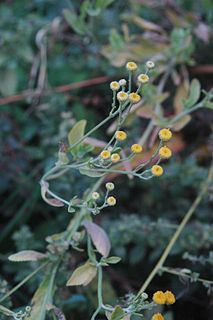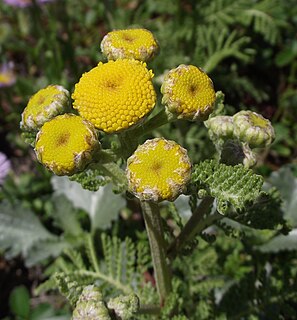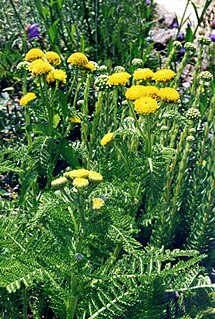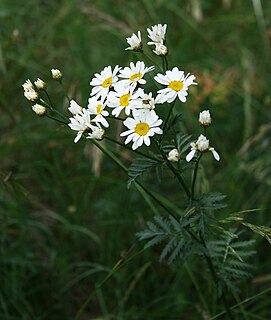Pyrethrum was a genus of several Old World plants now classified as Chrysanthemum or Tanacetum which are cultivated as ornamentals for their showy flower heads. Pyrethrum continues to be used as a common name for plants formerly included in the genus Pyrethrum. Pyrethrum is also the name of a natural insecticide made from the dried flower heads of Chrysanthemum cinerariifolium and Chrysanthemum coccineum. Its active ingredient are pyrethrins.

Tanacetum is a genus of about 160 species of flowering plants in the aster family, Asteraceae, native to many regions of the Northern Hemisphere. They are known commonly as tansies. The name tansy can refer specifically to Tanacetum vulgare, which may be called the common tansy or garden tansy for clarity.

Tansy is a perennial, herbaceous flowering plant of the aster family, native to temperate Europe and Asia. It has been introduced to other parts of the world, including North America, and in some areas has become invasive. It is also known as common tansy, bitter buttons, cow bitter, or golden buttons. The Latin word vulgare means "common".

Tanacetum parthenium, known as feverfew, is a flowering plant in the daisy family, Asteraceae. It may be grown as an ornament, and is usually identified by its synonyms, Chrysanthemum parthenium and Pyrethrum parthenium.

Parthenolide is a sesquiterpene lactone of the germacranolide class which occurs naturally in the plant feverfew, after which it is named. It is found in highest concentration in the flowers and fruit. Parthenolide's molecular structure depiction is often incorrect regarding the stereochemistry of the epoxide, although X-ray single crystal structures are available.

Tanacetum balsamita is a perennial temperate herb known as costmary, alecost, balsam herb, bible leaf, or mint geranium.

Dimethylallyltranstransferase (DMATT), also known as farnesylpyrophosphate synthase (FPPS) or as farnesyldiphosphate synthase (FDPS), is an enzyme that in humans is encoded by the FDPS gene and catalyzes the transformation of dimethylallylpyrophosphate (DMAPP) and isopentenyl pyrophosphate (IPP) into farnesylpyrophosphate (FPP).

Gillmeria ochrodactyla is a moth of the family Pterophoridae found in Asia and Europe. It was first described by the Austrian entomologists, Michael Denis & Ignaz Schiffermüller in 1775.

Dichrorampha sedatana is a moth of the family Tortricidae.

Centaureidin is an O-methylated flavonol. It can be isolated from Tanacetum microphyllum, Achillea millefolium, Brickellia veronicaefolia, Bidens pilosa and Polymnia fruticosa.

Santin is an O-methylated flavonol. It was isolated from Tanacetum microphyllum.

Axillarin is an O-methylated flavonol. It can be found in Pulicaria crispa, Filifolium sibiricum, Inula britannica, Wyethia bolanderi in Balsamorhiza macrophylla and in Tanacetum vulgare. It can also be synthetized.

Coleophora tanaceti is a moth of the family Coleophoridae. It is found from Spain, north to Fennoscandia, east to the Baltic region, south to Italy and Bulgaria. It has also been recorded from the Near East.

Tanacetum camphoratum is a species of flowering plant in the aster family known by the common names camphor tansy and dune tansy. It is native to the Pacific Coast of North America from British Columbia to California, where it grows in sand dunes and other coastline habitat. This species may be known by the synonym Tanacetum douglasii and is often included in Tanacetum bipinnatum. It is a rhizomatous perennial herb with a thick, low-lying stem up to 25 centimeters long, branching to form a mass of vegetation. It is hairy, glandular, and aromatic, with a camphor scent. The leaves are up to 25 centimeters long and thick but featherlike, divided into many narrow leaflets on each side of the main rachis. Each leaflet in turn has many segments along each side, and the segments are usually divided into several small, knobby segments with folded or curled edges. The inflorescence bears up to 15 flower heads, each about a centimeter wide or slightly wider. Each head contains many yellowish disc florets and many pistillate florets around the edges. The latter may have minute ray florets. The fruit is an achene a few millimeters long which is tipped with a small pappus of toothed scales.

Tanacetum cinerariifolium is a species of flowering plant in the aster family, Asteraceae., and formerly part of the genus Pyrethrum, but now placed in the genus Chrysanthemum, or the genus Tanacetum by some biologists. It is called the Dalmatian chrysanthemum, denoting its origin in that region of Europe (Dalmatia). It looks more like the common daisy than other pyrethrums do. Its flowers, typically white with yellow centers, grow from numerous fairly rigid stems. Plants have blue-green leaves and grow to 45 to 100 cm in height.

Tanacetum microphyllum is a species of flowering plant in the aster family, Asteraceae. It is endemic to the Iberian Peninsula.

Depressaria olerella is a moth of the family Depressariidae. It is found in most of Europe, except Ireland, the Netherlands, the Iberian Peninsula and most of the Balkan Peninsula.

Dichrorampha vancouverana, the tanacetum root moth, is a moth of the family Tortricidae.

Tanacetum huronense, also known as Lake Huron tansy, is a type of wildflower most commonly found on sand dunes around the Great Lakes. Lake Huron tansy currently requires conservation measures in some regions.

Tanacetum corymbosum is a species of flowering plant belonging to the family Asteraceae.


















